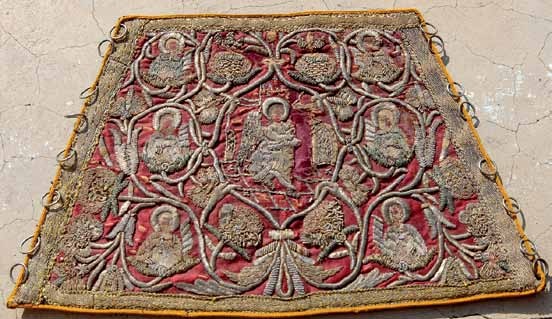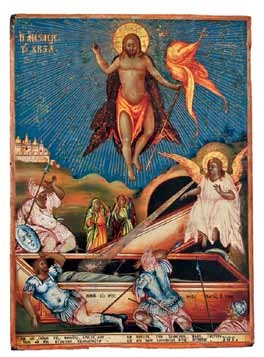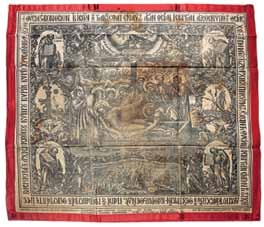Bank of Cyprus Cultural Foundation Events & Publications
3 Νοεμβρίου 2012
The Foundation is devoted to preserving and promoting the island’s cultural and natural heritage in both Cyprus and abroad
The Exhibition will showcases portable icons, golden embroideries, metalworking and manuscripts.
The Bank of Cyprus Cultural Foundation was established in 1984, a decade after the Turkish invasion and the beginning of the ongoing occupation of the northern part of the island. The Foundation was born out of the Bank’s desire to assist in the rescue of the island’s cultural heritage, which has been pillaged or stolen by Turkish forces in the occupied areas, and to promote the Hellenic culture of Cyprus at a professional and scholarly level.
Thus, while the context of all projects undertaken by the Foundation is meant to be Cyprological, i.e., pertaining to Cyprus (art, history, literature, etc.), the philosophy and policy of the Foundation is to promote the Hellenic character of Cyprus, in as much as the island is part of the wider Hellenic world. This assessment does not by any means detract from the unique, historical development of Cyprus from antiquity to the present. The Foundation is devoted to preserving and promoting the island’s cultural and natural heritage in both Cyprus and abroad; the Foundation aspires to bring the Cypriot public closer to the history, art and culture of the broader Hellenic area and of other nations. From a Cyprological perspective, its objectives are achieved by placing particular emphasis on research into primary and other sources in the fields of archaeology, art, history, and literature. Research is complemented by publications in all of the aforementioned fields, and by events, educational programs and lectures. The Bank of Cyprus bequeathed numerous collections to the Cultural Foundation and the Foundation continues to preserve and enrich these collections while finding practical ways to support the arts and culture in Cyprus.
In February 2000 the Greek authorities granted permission for a branch of the Cultural Foundation to be opened in Greece. The branch is located at the administrative headquarters of the Bank of Cyprus in Athens. The aim of the establishment of this branch is to strengthen cooperation between the
Cultural Foundation and foundations in Greece, and to contribute to cultural issues concerning the Hellenic world as a whole. Today, the Foundation curates two museums and six collections of rare value. With a firm belief that it is the Foundation’s duty to make this wealth available to the public, the Foundation has embarked on an ambitious program of scientific publications devoted to the entire range of its collections.
Periodical Exhibition of the Bank of Cyprus Cultural Foundation and Phaneromeni Church, Nicosia
(22 March-31 December 2012)
Our Lady of Lefkosia: The Church of Phaneromeni and its Relics
The Bank of Cyprus Cultural Foundation and the Ecclesiastical Board of Panagia Phaneromeni Church in Nicosia are the co-organisers of an exhibition entitled Our Lady of Lefkosia. The Church of Phaneromeni and its Relics. The exhibition was inaugurated on 22 March 2012 by his Beatitude Chrysostomos II the Archbishop of Cyprus, at the Bank of Cyprus Cultural Foundation, in Phaneromeni, and is scheduled to run until 31 December 2012.
This is the first time these important relics have been presented to the public. Both the exhibition and the supplemental publication are meant to present a diachronic account of the history and contribution of the Church of Our Lady Phaneromeni to the city of Nicosia within the walls and to the wider island.
Exhibition
The exhibition showcases portable icons, post- Byzantine art woodcuts, carved stone reliefs, golden embroideries, metalworking and manuscripts dating from the 12th to the 20th century. Portable icons originating from Phaneromeni are on loan from the Byzantine Museum of the Archbishop Makarios III Foundation More than a hundred representative specimens are displayed in separate units, complemented by pertinent visual material and text. The exhibition comprises the history of the Church Saints of Nicosia icons of Our Lord Jesus Christ icons of Our Lady icons with individual Saints, icons with the Lives of Saints, icons and objects from the Holy Land, sacerdotal vestments and embroidery, religious works by Ioannis Kissonergis and Adamantios Diamantis, and tokens offered to the poet Dimitris Lipertis which were subsequently donated to Phaneromeni Church. Among the objects on display are the icon meant for public veneration of Our Lady Phaneromeni (probably 12th century); the icon of Our Lady Vlahernitissa (13th century) now kept in the Byzantine Museum of the Archbishop Makarios III Foundation; the icon of St George with scenes from his life (13th century); a dedicatory icon with the family of dragoman Hadjijoseph ( 18th century); the icon of St Paul with scenes from his life (1789), a gift of dragoman Hadjigeorgakis Kornesios; an embroidered epitaph a gift of the Archimandrite Kyprianos (18th century); a sacred Chalice and a sacred Paten (1800); a vessel for the Prothesis, and works of the renowned goldsmith Polyvios Kolokos (1926). Also on exhibition is the icon of St Fanourios that used to belong to the martyr Archbishop Kyprianos of Cyprus (1810-1821); the icon of Kyriaki Samareitis (19th century), a work of the painter Christodoulos, and the icon with the representation of the 9th Eothinon Gospel’s “Tiberian Sea”.
Parallel Events
Parallel events in tandem with the exhibition include scientific meetings, tours, educational programs and music events with the participation of the choir of the Church of Panagia Phaneromeni.
History of Our Lady Phaneromeni Church
The Church of Panagia Phaneromeni is located at the historic centre of the old city of Nicosia.
It is the largest Orthodox Church in Nicosia within the walls, built on what used to be a Medieval Orthodox convent. Although the convent seems to have been ruined after the conquest of Nicosia by the Ottomans in 1571, its church continued to operate as a parish church. Tradition has it the Turks attempted to convert the church into a mosque, but they abandoned the idea, as the imams appointed to the mosque died one after the other, not long after each took up his duties. The Turkish Administrator of Cyprus, Kuçuk Mehmet Pasha, tried to convert the church into a mosque in 1821, but this attempt was also halted by Our Lady’s miraculous intervention.
According to a marble proprietary inscription, the previous church was built in 1715. Archimandrite Kyprianos, a learned man from the 18th century, ranks Phaneromeni among the nine Orthodox churches of Nicosia and described it as “ancient and very old”. The present building was constructed in 1872- 1873. It belongs to the three-aisled basilica type, with a dome, and includes a number of features which demonstrate the influence of Western architecture.
National Martyrs Mausoleum
There is a mausoleum of fine marble in the churchyard, wherein the relics of clerics and laymen slaughtered by the Turks in 1821 arc kept, together with the relics of a national martyr, the Bishop of Mareotis Dionysius Kykkotis, who served in Phaneromeni.
Phaneromeni Library
The Library of Phaneromeni was founded in 1933 and still operates today, with its expenses paid by the Phaneromeni Church. The Library contains a wealth of writings, rare collections and books, approximately 20,000 volumes. Following a decision of Archbishop Chrysostomos I, the books have been transferred to the Library of Archbishop Makarios III Foundation in Nicosia.
Bank of Cyprus Publication Programme
Today, the Cultural Foundation’s Publications Programme can be proud of no less than the one hundred publications it has produced over the past two decades. This includes editions in the fields of cartography, coinage, history and archaeology; guides to archaeological, byzantine and historical monuments; literaturo, children’s and young adult books; art; publications on the environment; studies of the Foundation’s collections, and a broad spectrum of Cyprological studies. The programme also includes publications. CDs and video productions issued by the Cultural Foundation in collaboration with other organisations, both in Cyprus and abroad.
New Edition ‘Guides to Byzantine Monuments’:
The Church of Our Lady of Amasgou in Monagri
Launched in 2002 in cooperation with the Holy Bishopric of Morphou and the Department of Antiquities, the “Guides to Byzantine Monuments” series will initially cover the architecture, art and history of seven of the ten Byzantine and post-Byzantine monuments in Cyprus on the UNESCO World Heritage List which fall under the jurisdiction of the Holy Bishopric of Morphou. Net proceeds from the sale of the Guides are deposited in a special Fund set up by the Holy Bishopric of Morphou for the conservation needs of the monuments. Apart from the Byzantine monuments of Cyprus included on the UNESCO World Heritage List, the guide series also covers additional monuments of significance found in Cyprus, both Byzantine and post-Byzantine. Net proceeds from sales of the Guides arc ceded to special funds at Holy Bishoprics and Monasteries for the restoration needs of the monuments.
The sixth volume of the series “Guides to Byzantine Monuments of Cyprus”, The Church of Panagia Amasgou at Monagri, is now in circulation. The book was published by the Bank of Cyprus Cultural Foundation in collaboration with the Holy Bishopric of Limassol and the Department of Antiquities. Yiannis Kypri, the Chairman of the Bank of Cyprus Cultural Foundation, wrote the foreword. Addresses by the Most Reverend Athanassios, Metropolitan of Limassol, and the Abbess of the Monastery of Panagia Amasgou, Nun Epiphania, follow.
The Guide offers a retrospective on the history of the Monastery and on the architecture and art of its katholikon, which is dedicated to the Entrance of Theotokos into the Temple. An account on the Byzantine church of St Marina at Kantou, a dependency of the Monastery of Panagia Amasgou, is part of the Guide, together with a chapter on the mobile finds of recent excavations carried out on the site by the Department of Antiquities. The church belongs to the wooden-roofed type, proper to Cypriot Church architecture, and the chapter on the church’s architecture presents the monument’s typology, as well as its different construction phases and building materials. There is also extensive text on the church’s wall-paintings, which were painted on five different layers between the 12th century and the 16th century. The last chapter of the Guide covers the carved wooden iconostasis of the 17th century, portable icons from the 12th to the 19th century, and sacred vessels, followed by the topographical and architectural plans for the church that indicate the position of the wall-paintings. A glossary and bibliography are provided at the end of the Guide.
The history of the Monastery included in the foreword was written by the Very Reverend Archimandrite Epiphanios Efthyvoulou. The discussion of the church’s architecture was written by the architect Diomedes Myriantheas, while the chapter on the Church of St Marina at Kantou was written by the archaeologist Doria Nikolaou. Giorgos Philotheou, an archaeologist at the Department of Antiquities, addresses the wall paintings, while Christodoulos Hadjichristodoulou, an archaeologist and curator of Collections at the Bank of Cyprus Cultural Foundation, authored the sections on iconography, portable icons and sacred vessels.
The architectural designs were prepared by Diomedes Myriantheas, Vassos Stylianou took all of the new photographs in the Guide, and the Department of Antiquities provided archival photographs and images. The artistic and typographical editing, as well as the separation of colours, was performed by En Typois Voula Kokkinou Ltd. The Guide was printed by printers-lithographers Kailas Ltd. and is available in English, Russian and German It is on sale at Agora, the Cultural Foundation bookstore and gift shop, at the Holy Metropolis of Limassol, at the Church of Panagia Amasgou in Monagri, and at well-known bookstores throughout Cyprus. It is also available online from the Bank of Cyprus Cultural Foundation at www.boccf.org .
Portable icons originating from Phaneromeni will be loaned by the Byzantine Museum of the Archbishop Makarios III Foundation.
More than a hundred representative specimens will be displayed in separate units.






